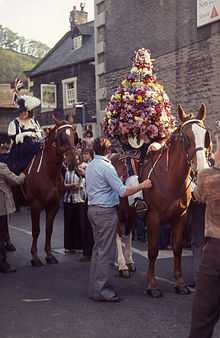Castleton Garland Day

Castleton Garland Day or Garland King Day is held on 29 May (unless that date falls on a Sunday, when the custom is transferred to the Saturday) in the town of Castleton in the Derbyshire Peak District. The Garland King, on horseback, and covered to the waist in a heavy, bell-shaped floral Garland, leads a procession through the town.[1]
Origins
The date of the custom coincides with Oak Apple Day and it is said to commemorate the restoration of King Charles II in 1660. Presumably the Garland is meant to represent the oak tree in which he hid after the Battle of Worcester. Some folklorists suspect that it is actually a much older custom that transferred from May Day[2] as many May celebrations did after having been banned by the Puritans.[3] The Garland King certainly resembles a kind of Jack in the Green.
The custom
Starting from midday, most of the afternoon is taken up with the construction of the Garland, a roughly bell- or beehive-shaped wooden framework to which are tied bunches of garden flowers. Once it is finished, a small posy named "The Queen", made of especially fine flowers tied around a short stick, is inserted as a topknot into the top of the garland.[2]
In the late afternoon the Garland King and his female consort (confusingly, sometimes mistakenly referred to as "The Queen", but formerly simply "The Lady"), dressed in Stuart costume, mount their horses. The Garland, which is said to weigh between 56 and 60 lb (25 and 27 kg)[1][2] is placed over the King's head and shoulders; only his legs are visible beneath it. The dance starts at one of the village's pubs (the starting point is chosen on rotation). The riders and Castleton Silver Band then lead an evening procession around the town, stopping at various points, including all the pubs. Young schoolgirls dressed in white, with flowers, carrying small "maypoles" (known as "Garland sticks") twined with ribbons, follow behind; they dance a form of morris dance at each stopping-place.[2]
When the circuit of the village is complete, the King rides up to the churchyard gates, where the Queen (posy) is removed from the top of the Garland. It is kept on one side to be placed on the village's war memorial. The King rides to the foot of the tower of St Edmund's church where all the pinnacles but one have been decorated with oak leaf branches. A long rope is hung down and tied to the Garland, which is hoisted up the side of the tower and then impaled on the central pinnacle. It remains there for several days until the flowers have wilted. Formerly it was left to fall apart completely.[2]
The day concludes with maypole dancing in the Market Place and the ceremonial placing of the Queen posy on the war memorial. Then the residents of the village follow the band back through the village dancing the "Crossover Dance". [4]
History
In the ancient tradition of the "man-woman" (a man dressed as a woman for ritual reasons), the Lady was played by a man until 1956. The whole ceremony was formerly organised by the bellringers, who themselves danced a morris behind the King and Lady.[2] Castleton Museum has a display of Garland day memorabilia, including a costume worn by the King over two centuries ago.[1]
The garland tune is similar to that used by the Helston Furry Dance. This is locally thought to be due to miners moving either from Castleton to Helston, or from Helston to Castleton.
Castleton Garland Day (c.1976)
-

Constructing the garland
-

The finished garland
-

Garland with "Queen" posy
-

The King in costume
-

Dancing outside a pub
-

Dancers in procession
-

Procession approaching churchyard gates
-

Removing the "Queen"
-

Garland on St Edmund's church tower
-

Garland on pinnacle (castle in distance)
See also
External links
| Wikimedia Commons has media related to Castleton Garland Day. |
References
- ↑ 1.0 1.1 1.2 Derbyshire website: Derbyshire and Peak District Customs; Castleton Garland Day
- ↑ 2.0 2.1 2.2 2.3 2.4 2.5 Hole, Christina (1978). A Dictionary of British Folk Customs, pp114–115, Paladin Granada, ISBN 0-586-08293-X
- ↑ Hole, Christina. op.cit., pp205–206
- ↑ Visit Peak District website: Castleton Ancient Garland Ceremony at Castleton